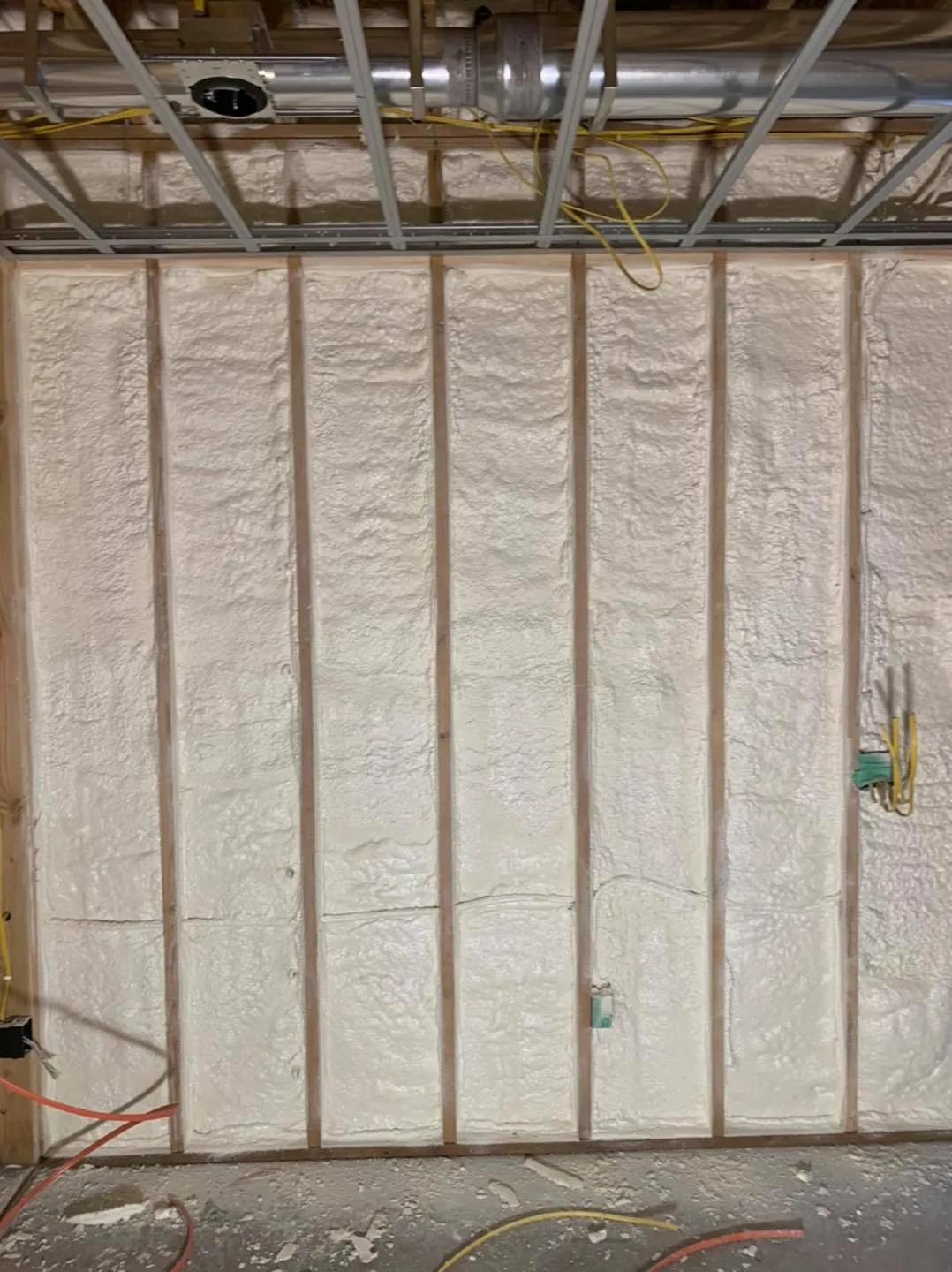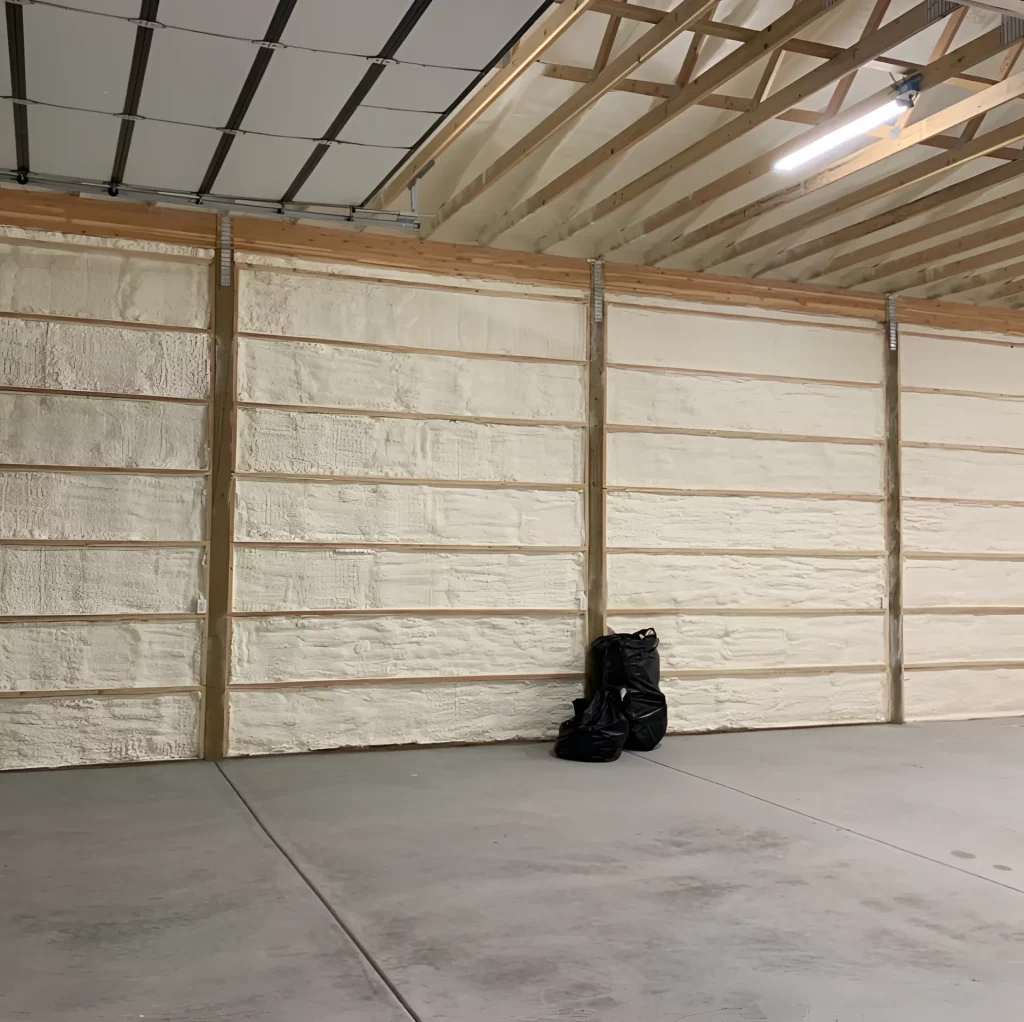
For workshops and metal buildings in Soda Springs, Idaho, spray foam insulation is an excellent choice. Its ability to create a complete air and moisture barrier makes it uniquely suited to the region’s cold, snowy winters and dry summers. By adhering directly to metal surfaces, it stops condensation before it starts, protects the building’s structural integrity, and provides a high R-value in a single application. While other insulation types can work, spray foam offers a more comprehensive solution for climate control and energy efficiency.
To understand its benefits for the Soda Springs climate, let’s explore how spray foam insulation performs in metal buildings and the key factors to consider before making a decision. This guidance comes from extensive field experience helping owners properly insulate their workshops and utility buildings.
Unlike traditional insulation like fiberglass batts, which are placed between studs, spray polyurethane foam (SPF) is applied as a liquid. It expands to fill every crack and gap, creating a solid, seamless barrier that is bonded directly to the metal substrate. This application is what makes it so effective in metal structures, which are prone to air leaks and temperature fluctuations.
There are two main types of spray foam:
A key benefit of closed-cell foam is its structural strength. When applied to the interior of metal panels, it can actually add rigidity to the entire building, helping it withstand wind and snow loads more effectively.
The climate in Soda Springs presents specific challenges for any building, especially large-volume metal structures. With cold, long winters and significant temperature swings, managing energy use and moisture is essential.
Proper insulation and air sealing are the most effective ways to make a building more energy-efficient. Information from the U.S. Department of Energy shows that air leaks can account for a large portion of a building’s heating and cooling costs. In a metal workshop with many seams and joints, this problem is amplified. Spray foam’s ability to seal these leaks results in a stable interior temperature and lower energy bills.
The biggest enemy of a metal building is condensation. When warm, moist air from inside a heated workshop hits the cold metal panels, water vapor condenses into liquid, a phenomenon known as “sweating.” This moisture can drip onto equipment, ruin stored materials, and lead to rust and corrosion over time. Closed-cell spray foam applied directly to the metal panel stops this process entirely by keeping the warm interior air from ever touching the cold metal surface.
Bonus Tip: Before insulating, check for and repair any existing leaks in the roof or walls. While spray foam can seal small gaps, it’s not a substitute for proper building maintenance.
To put spray foam’s performance into perspective, it helps to compare it with other common insulation materials. While each has its place, some are better suited than others for the unique demands of metal buildings.
| Feature | Closed-Cell Spray Foam | Fiberglass Batts | Rigid Foam Board |
|---|---|---|---|
| Typical R-Value | R-6.5 per inch | R-3.2 per inch | R-4.5 per inch |
| Air Sealing | Excellent | Poor | Fair (seams must be taped) |
| Vapor Barrier | Yes (built-in) | No (requires separate barrier) | Yes (some types) |
| Condensation Control | Excellent | Poor (can trap moisture) | Good (if installed perfectly) |
| Installation | Professional Only | DIY Friendly | DIY Friendly |
This comparison shows that while fiberglass is inexpensive, it struggles with the two most important jobs in a metal building: air sealing and preventing condensation. Rigid foam board is a better option, but achieving a perfect seal at every seam is difficult. Spray foam handles all these requirements in one step.

Choosing the right insulation involves more than just picking the material with the highest R-value. Here are a few practical factors to think about.
How you plan to use your workshop or metal building is the most important factor.
Because closed-cell spray foam creates an exceptionally airtight building, you have to control the indoor air quality. Without natural air leaks, moisture, dust, and fumes can build up inside. Planning for mechanical ventilation, like an exhaust fan or an air-to-air exchanger, is often necessary, particularly if you’ll be welding, painting, or running engines.
Spray foam insulation is a chemical product that requires precise installation techniques, temperatures, and safety protocols. According to the Environmental Protection Agency, the application process should only be handled by trained professionals with the correct personal protective equipment (PPE). A DIY attempt can lead to a poor chemical ratio, resulting in foam that doesn’t cure properly and may off-gas for an extended period.
Bonus Tip: Always get multiple quotes from qualified installers. Ask about their experience with metal buildings specifically and request references you can talk to.
For creating a comfortable, efficient, and long-lasting workshop in Soda Springs, spray foam insulation is a powerful tool that directly addresses the local climate’s challenges. By stopping air leaks and condensation, it lowers energy bills while protecting the building and its contents. Ultimately, the right choice depends on your specific goals, intended use for the space, and long-term budget.
Understanding the specific needs of your building is the first step. For a clear evaluation and to discuss the best insulation strategy for your workshop or metal building, contact High Country Solutions. You can reach the team by phone at (307) 248-9063 or by email at [email protected] to get straightforward advice based on years of experience in the region. A professional consultation can help determine the right approach to make your space comfortable and efficient for years to come.
The cost varies based on the total square footage, the thickness of the foam applied, and whether the job requires extensive prep work. While the upfront cost is higher than for fiberglass, the long-term energy savings and building protection often provide a strong return on investment.
Absolutely. The key is surface preparation. The metal panels must be clean, dry, and free from any oil, grease, or loose rust before the foam is applied. In some cases, a primer may be needed to ensure proper adhesion.
Spray foam is very durable. Because it’s a rigid, inert polymer once cured, it doesn’t sag, settle, or lose its R-value over time like some other insulation types. It becomes a permanent part of the building structure and should last for the life of the building itself.
Spray foam is a combustible material, like many building products. Building codes typically require it to be covered by an approved 15-minute thermal barrier, such as drywall or a special intumescent coating, in any occupied space.